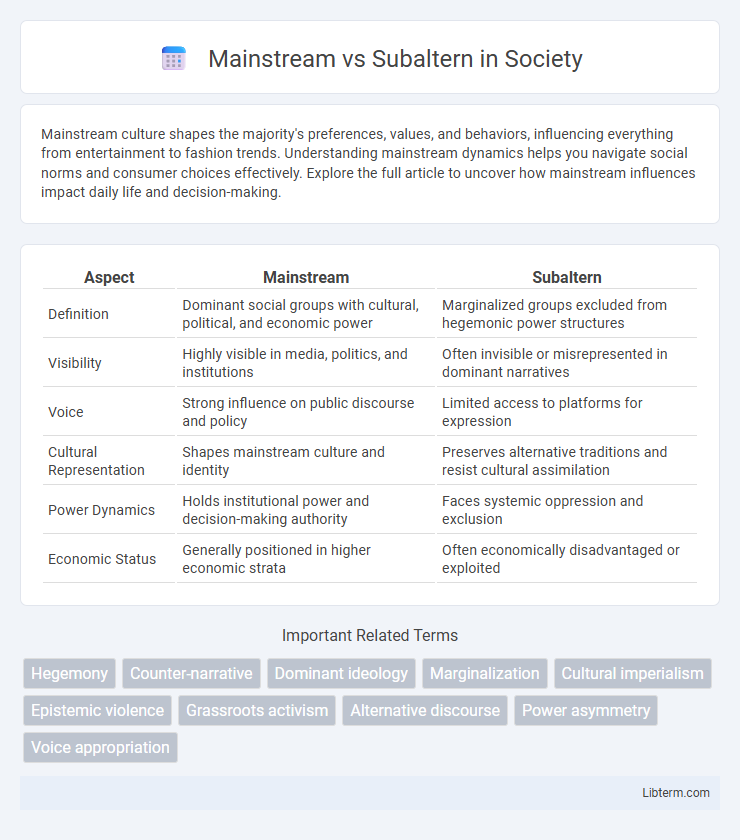Mainstream culture shapes the majority's preferences, values, and behaviors, influencing everything from entertainment to fashion trends. Understanding mainstream dynamics helps you navigate social norms and consumer choices effectively. Explore the full article to uncover how mainstream influences impact daily life and decision-making.
Table of Comparison
| Aspect | Mainstream | Subaltern |
|---|---|---|
| Definition | Dominant social groups with cultural, political, and economic power | Marginalized groups excluded from hegemonic power structures |
| Visibility | Highly visible in media, politics, and institutions | Often invisible or misrepresented in dominant narratives |
| Voice | Strong influence on public discourse and policy | Limited access to platforms for expression |
| Cultural Representation | Shapes mainstream culture and identity | Preserves alternative traditions and resist cultural assimilation |
| Power Dynamics | Holds institutional power and decision-making authority | Faces systemic oppression and exclusion |
| Economic Status | Generally positioned in higher economic strata | Often economically disadvantaged or exploited |
Understanding Mainstream and Subaltern: Definitions
Mainstream refers to the dominant cultural norms, values, and institutions widely accepted and promoted by society, typically reflecting the perspectives of those in power. Subaltern denotes marginalized or oppressed groups whose voices and experiences are excluded from mainstream narratives and institutional recognition. Understanding mainstream and subaltern involves analyzing power dynamics and the representation of identity, culture, and knowledge within social and political contexts.
Historical Development of Mainstream and Subaltern Concepts
The historical development of mainstream and subaltern concepts traces back to postcolonial theory and critical studies, where mainstream reflects dominant cultural, political, and economic narratives, while subaltern represents marginalized or oppressed groups excluded from power structures. Key contributions by scholars like Antonio Gramsci, who introduced "subaltern" as a class concept, and Gayatri Spivak, who emphasized the silencing of subaltern voices, shaped how these ideas evolved in academic discourse. Over time, mainstream and subaltern frameworks have increasingly informed discussions on hegemony, resistance, and social justice in historical and contemporary contexts.
Power Dynamics Between Mainstream and Subaltern Groups
Power dynamics between mainstream and subaltern groups center on control, representation, and access to resources, where mainstream entities often dominate cultural, economic, and political narratives. Subaltern groups face systemic marginalization, limiting their ability to influence decision-making and challenge dominant ideologies. Understanding these interactions reveals how hegemonic structures maintain inequality and suppress alternative voices.
Representation in Media: Mainstream vs Subaltern Voices
Mainstream media predominantly features dominant cultural narratives that reflect the perspectives of majority groups, often marginalizing or misrepresenting subaltern voices. Subaltern representation in media challenges these hegemonic discourses by highlighting marginalized communities' lived experiences and diverse identities, fostering social awareness and inclusivity. Amplifying subaltern narratives disrupts conventional power dynamics in representation, enabling a more equitable media landscape that values plurality and authenticity.
Language and Discourse: Who Controls the Narrative?
Mainstream discourse often reflects dominant cultural and institutional perspectives, shaping narratives through widely accessible language and media channels. Subaltern groups, marginalized by these dominant narratives, use alternative languages and discursive practices to challenge and resist the hegemonic control of meaning and representation. Control over language and discourse determines who legitimizes knowledge and whose stories are heard, influencing power dynamics in society.
Social Identity and Inclusion: Barriers and Opportunities
Mainstream social identity often reinforces dominant cultural norms, creating barriers to inclusion for subaltern groups that face marginalization due to race, class, or ethnicity. Subaltern identities challenge these hegemonic structures by asserting alternative narratives and fostering community solidarity, which can open opportunities for social empowerment and policy change. Understanding the dynamics between mainstream and subaltern perspectives is crucial for developing inclusive frameworks that address systemic inequalities and promote equitable participation.
Marginalization: Causes and Consequences
Marginalization arises from systemic power imbalances where mainstream groups dominate institutional narratives and resource allocation, sidelining subaltern voices. This exclusion leads to limited access to education, healthcare, and political representation for marginalized communities, perpetuating cycles of poverty and social inequality. The consequences include cultural erasure, diminished agency, and sustained socio-economic disparities that hinder inclusive development.
Strategies for Subaltern Empowerment
Strategies for subaltern empowerment emphasize inclusive education, participatory governance, and grassroots mobilization to challenge dominant mainstream narratives. Strengthening local leadership and fostering critical awareness helps marginalized groups assert their rights and cultural identity. Access to resources, legal protection, and platforms for voice amplification are crucial for realizing social justice and equity.
Intersectionality: Overlapping Subaltern Identities
Mainstream discourse often marginalizes subaltern identities by overlooking the complexity of intersectionality, where race, gender, class, and other social categories overlap to create compounded experiences of oppression. Subaltern studies emphasize the importance of recognizing these intersecting identities to challenge dominant narratives that simplify or erase multifaceted marginalization. Understanding overlapping subaltern identities is crucial for addressing systemic inequalities and advocating for more inclusive social justice frameworks.
Challenging the Mainstream: Pathways to Social Change
Challenging the mainstream involves recognizing the voices and experiences of subaltern groups often marginalized in dominant narratives. Social change pathways emerge from grassroots movements, alternative media, and critical pedagogy that disrupt hegemonic power structures. Empowering subaltern communities fosters inclusive policies and transformational justice beyond traditional institutions.
Mainstream Infographic

 libterm.com
libterm.com